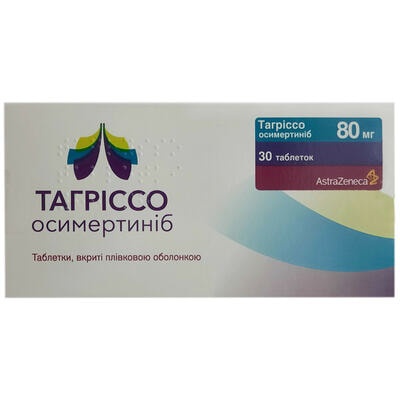
How to use TAGRISSO
INSTRUCTIONS for medical use of the medicinal product GLUCOSE
Composition
active substance: glucose; 1 ml of solution contains 50 mg of glucose monohydrate (in terms of 100% substance); excipient: water for injections.
Pharmaceutical form
Solution for infusions.
Main physical and chemical properties
Colorless or slightly yellowish transparent liquid.
Pharmacotherapeutic group
Blood substitutes and perfusion solutions. ATC code V05CX01.
Pharmacological properties
Pharmacodynamics
A 5% glucose solution is isotonic to plasma and, when administered intravenously, replenishes the volume of circulating blood, serves as a source of nutrients when lost, and also helps to remove toxins from the body. Glucose provides substrate replenishment of energy expenditures. With intravenous injections, it activates metabolic processes, improves the antitoxic function of the liver, enhances the contractile activity of the myocardium, dilates blood vessels, and increases diuresis.
Pharmacokinetics
After administration, it is quickly distributed in the body tissues. Excreted by the kidneys.
Clinical characteristics
Indications
- Hypertonic and isotonic dehydration;
- in children to prevent disturbances of water-electrolyte balance during surgical interventions;
- intoxication;
- hypoglycemia;
- as a solvent for other compatible solutions of medicinal products.
Contraindications
The 5% glucose solution is contraindicated in patients with:
- hyperglycemia;
- hypersensitivity to dextrose.
The preparation should not be administered simultaneously with blood products.
Interaction with other medicinal products and other types of interactions
When used concurrently with thiazide diuretics and furosemide, their ability to affect glucose levels in serum should be taken into account. Insulin facilitates the entry of glucose into peripheral tissues. The glucose solution reduces the toxic effect of pyrazinamide on the liver. The administration of a large volume of glucose solution contributes to the development of hypokalemia, which increases the toxicity of concurrently used digitalis preparations. The glucose solution is incompatible with aminophylline, soluble barbiturates, hydrocortisone, kanamycin, soluble sulfonamides, and cyanocobalamin.
Special instructions
The preparation should be used with great caution in patients with intracranial and intraspinal hemorrhages.
With prolonged intravenous use of the preparation, monitoring of blood sugar levels is necessary.
To prevent the occurrence of hypo-osmolar plasma, a 5% glucose solution can be combined with the administration of an isotonic sodium chloride solution.
When administering large doses, insulin can be prescribed subcutaneously at a dose of 1 IU per 4-5 grams of glucose if necessary.
The contents of the bottle can only be used for one patient. After the bottle or container is opened, the unused portion of the contents should be discarded.
Use during pregnancy or breastfeeding
The preparation can be used as indicated.
Ability to affect reaction speed when driving vehicles or operating other mechanisms
Data are not available due to the exclusive use of the preparation in a hospital setting.
Method of administration and dosage
The preparation is administered intravenously by drip. The dose for adults is up to 1500 ml per day. The maximum daily dose for adults is 2000 ml. If necessary, the maximum infusion rate for adults is 150 drops per minute (500 ml/hour).
Children
The dose for children depends on age, body weight, patient condition, and laboratory indicators.
Overdose
Enhancement of side effect manifestations.
Possible development of hyperglycemia and hypotonic hyperhydration. In case of overdose, symptomatic treatment and administration of regular insulin are prescribed.
Side effects
Disorders of electrolyte balance and general reactions of the body that occur during massive infusions:
- hypokalemia;
- hypophosphatemia;
- hypomagnesemia;
- hyponatremia;
- hypervolemia;
- hyperglycemia;
- allergic reactions (hyperthermia, skin rash, angioedema, shock).
Disorders from the gastrointestinal tract:
- very rarely - nausea of central origin.
In case of side effects, the administration of the solution should be stopped, the patient's condition should be assessed, and assistance should be provided.
Shelf life
3 years.
Storage conditions
Store in a place inaccessible to children at a temperature not exceeding 25°C. Store in the original packaging.
Incompatibility
The glucose solution is incompatible with aminophylline, soluble barbiturates, erythromycin, hydrocortisone, warfarin, kanamycin, soluble sulfonamides, and cyanocobalamin.
Do not use in the same system simultaneously or before or after hemotransfusion due to the possible occurrence of pseudoagglutination.
Packaging
200 ml or 250 ml, or 400 ml, or 500 ml in polymer containers;
200 ml or 400 ml in glass bottles.
Release category
By prescription.
Manufacturer
TOB "Yuriya-Farm".
Location of the manufacturer and address of the place of its activity
18030, Cherkasy, Verbovetskogo street, 108. Tel. (044) 281-01-01.
- Country of registration
- Active substance
- Prescription requiredYes
- Manufacturer
- This information is for reference only and does not constitute medical advice. Always consult a licensed doctor before taking any medication. Oladoctor is not responsible for medical decisions based on this content.
- Alternatives to TAGRISSODosage form: tablets, 250 mg tablets in blisterActive substance: gefitinibPrescription requiredDosage form: tablets, 100 mgActive substance: erlotinibManufacturer: Гетеро Лабз ЛімітедPrescription requiredDosage form: tablets, 150 mgActive substance: erlotinibManufacturer: Гетеро Лабз ЛімітедPrescription required
Alternatives to TAGRISSO in other countries
The best alternatives with the same active ingredient and therapeutic effect.
Alternative to TAGRISSO in Spain
Online doctors for TAGRISSO
Discuss dosage, side effects, interactions, contraindications, and prescription renewal for TAGRISSO – subject to medical assessment and local rules.







